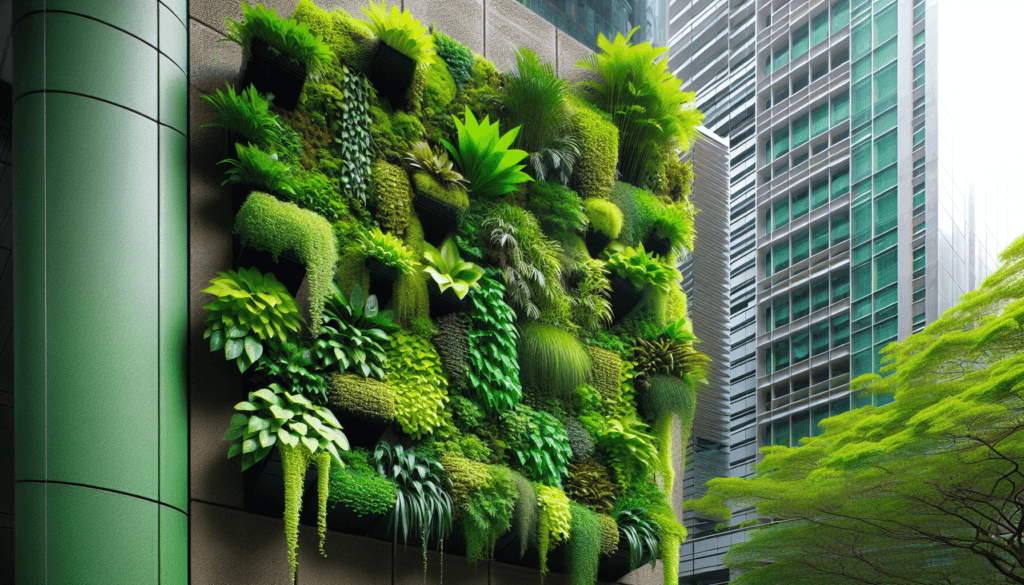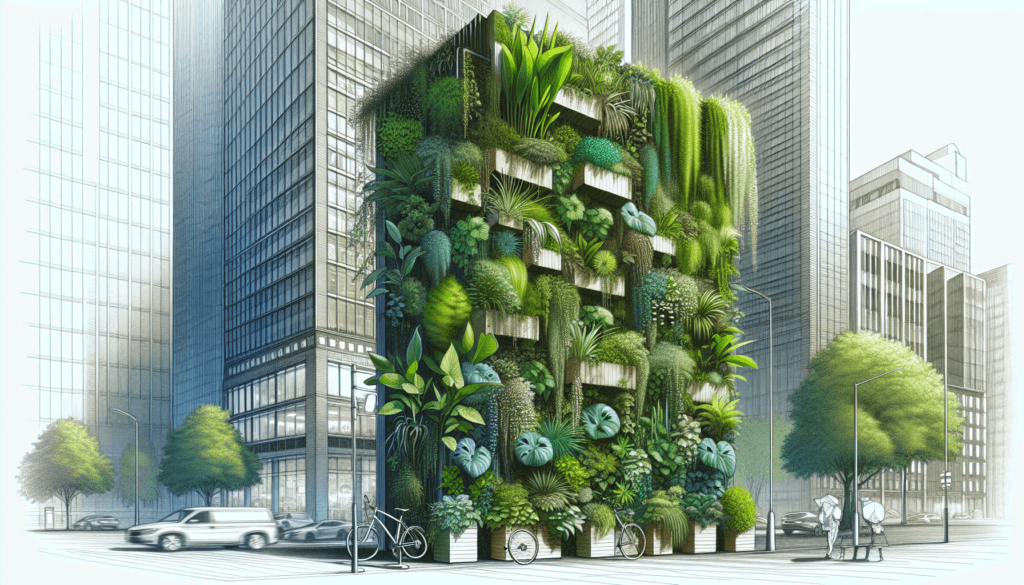If you’ve always dreamed of having a garden but don’t have the space, then a vertical garden might be the perfect solution for you. Not only does it add a touch of greenery to your space, but it also provides numerous benefits for the environment. In this article, you’ll discover some eco-friendly ways to design a vertical garden that not only looks beautiful but also promotes sustainability. So, get ready to transform your space into a vibrant oasis that is both stylish and environmentally conscious.

Choosing the Right Location
Assessing sunlight exposure
When choosing a location for your vertical garden, one of the key factors to consider is the amount of sunlight it will receive. Assess the sunlight exposure in different areas of your space to determine the best spot for your garden. Most plants require at least 6-8 hours of direct sunlight each day, so it’s important to choose a location that can provide this.
Considering wind patterns
Wind can have a significant impact on the health and stability of your vertical garden. Consider the wind patterns in your area and select a location that offers some protection from strong gusts. Windbreaks such as tall fences or buildings can help to shield your plants from excessive wind, ensuring they can grow and thrive without being damaged.
Determining water availability
Water is vital for the growth of any garden, and vertical gardens are no exception. Before setting up your vertical garden, assess the water availability in your chosen location. Ensure there is a convenient water source nearby or consider installing a water collection and storage system. This will ensure that your plants have a reliable water supply, even during dry periods.
Evaluating soil conditions
Vertical gardens offer the flexibility to grow plants in a variety of ways, including using soilless growing mediums such as coco coir or perlite. However, if you prefer using soil, it’s essential to evaluate the soil conditions in your chosen location. Conduct a soil test to check for nutrients, pH levels, and drainage. Depending on the results, you may need to amend the soil or consider alternative growing methods.
Selecting Suitable Plants
Considering native species
Choosing native plants for your vertical garden has numerous benefits. Native species are well-adapted to the local climate and soil conditions, making them more likely to thrive with minimal maintenance. They also provide important habitat and food sources for local wildlife, contributing to overall biodiversity. Research native plants in your area and select those that are suitable for vertical gardening.
Choosing low-maintenance plants
Not everyone has the time or inclination for high-maintenance gardening. If you prefer a low-maintenance vertical garden, choose plants that require minimal care. Look for plants that are drought-tolerant, disease-resistant, and have a long growing season. Succulents, some herbs, and certain ornamental grasses are excellent choices for low-maintenance vertical gardens.
Opting for edible plants
Vertical gardens can be a fantastic way to grow your own food, even in limited spaces. Consider incorporating edible plants into your vertical garden design. Herbs like basil, mint, and oregano are easy to grow and can be harvested as needed for culinary use. Leafy greens like lettuce, spinach, and kale are also great options for vertical gardens.
Selecting plants with vertical growth habits
To maximize the use of vertical space, choose plants that have a natural inclination to grow vertically. Vining plants like tomatoes, cucumbers, and beans can be trained to climb up trellises or support structures. This not only makes efficient use of space but also adds visual interest to your vertical garden.
Creating a Sustainable Support Structure
Using recycled or reclaimed materials
When designing your vertical garden support structure, consider using recycled or reclaimed materials. This reduces waste and gives new life to materials that would otherwise end up in landfill. Look for creative ways to repurpose materials like pallets, old ladders, or salvaged wood. Not only will this make your vertical garden more eco-friendly, but it will also add a unique aesthetic to your space.
Opting for natural materials
In line with the eco-friendly theme, consider using natural materials for your vertical garden support structure. Bamboo, for example, is a sustainable option that is strong, versatile, and aesthetically pleasing. You can use bamboo poles or fencing panels to create a sturdy framework for your vertical garden. Additionally, natural materials blend well with the surrounding environment, creating a harmonious and visually appealing space.
Designing for durability and longevity
When building your support structure, it’s important to choose materials that are durable and can withstand the elements. The support structure should be able to handle the weight of the plants and remain stable over time. Consider using weather-resistant materials such as stainless steel or treated wood. Investing in a sturdy structure will ensure that your vertical garden remains intact for years to come.
Considering the weight-bearing capacity
Before installing your support structure, evaluate its weight-bearing capacity. Ensure that it can support the weight of your plants, especially if you plan to include heavier plants or large planters. Overloading the support structure can compromise its stability and pose a safety risk. Consult with a professional or structural engineer if needed to ensure your support structure meets safety standards.
Implementing Proper Irrigation Methods
Utilizing drip irrigation
Drip irrigation is a highly efficient watering system that delivers water directly to the plant’s root zone. By using drip emitters or micro-sprayers, you can minimize water wastage and ensure that plants receive the right amount of water. Drip irrigation is particularly advantageous for vertical gardens as it prevents water runoff and keeps foliage dry, reducing the risk of diseases.
Harvesting rainwater
Incorporating rainwater harvesting into your vertical garden system is an excellent way to conserve water. Install rain barrels or a collection system to capture rainwater from your roof or other surfaces. This collected water can then be used to irrigate your vertical garden, reducing the demand for municipally supplied water. Not only does this save water, but it also helps to reduce your water bills.
Using a smart irrigation system
To further optimize your water usage, consider investing in a smart irrigation system. These systems use weather data, soil moisture sensors, and advanced scheduling algorithms to deliver water precisely when and where it’s needed. Smart irrigation systems can adjust watering schedules based on real-time conditions, ensuring that your plants receive adequate hydration without wasteful overwatering.
Minimizing water wastage
Water wastage can be a significant concern in vertical gardens. To minimize water wastage, take steps to improve water efficiency. Avoid overhead watering methods that can result in excessive runoff. Instead, water the plants at the base using a targeted watering method. Additionally, mulching the soil surface can help to retain moisture and reduce evaporation, further conserving water.

Promoting Natural Pest Control
Attracting beneficial insects
Encouraging beneficial insects to take up residence in your vertical garden can help naturally control pests. By planting flowers such as marigolds, lavender, or cosmos, you can attract pollinators and predators that feed on garden pests. Ladybugs, lacewings, and hoverflies are just a few examples of beneficial insects that can help keep your vertical garden pest-free.
Planting companion plants
Companion planting involves strategically placing plants together to benefit each other. Some plants have natural pest-repellent properties, while others attract beneficial insects or provide shade. For example, planting aromatic herbs like rosemary or thyme can help repel pests, while planting dill or fennel can attract beneficial insects like ladybugs. Research companion planting combinations that work well for vertical gardens and incorporate them into your design.
Using organic pest repellents
If pests become a persistent problem in your vertical garden, consider using organic pest repellents. There are many natural options available, such as neem oil, garlic spray, or insecticidal soap. These products are safe for the environment and can effectively control pests without harming beneficial insects or the health of your plants. Always follow the manufacturer’s instructions when using any pest repellent.
Implementing crop rotation
Crop rotation is a farming practice that helps prevent the buildup of pests and diseases in the soil. By rotating the plant families in your vertical garden each growing season, you disrupt pest and disease cycles, reducing the likelihood of infestations. Take note of which plants are vulnerable to specific pests or diseases and plan your crop rotation accordingly. This sustainable gardening practice can help maintain a healthy and thriving vertical garden.
Optimizing Nutrient Delivery
Using compost or organic fertilizers
To provide your plants with essential nutrients, incorporate compost or organic fertilizers into your vertical garden. Compost is a valuable source of organic matter and nutrients, improving soil fertility and structure. You can create your own compost using kitchen scraps and yard waste or purchase compost from local suppliers. Additionally, there are many organic fertilizers available, such as fish emulsion or seaweed extract, that provide a balanced nutrient boost for your plants.
Applying slow-release fertilizers
Slow-release fertilizers are a convenient way to provide a steady supply of nutrients to your plants over an extended period. These fertilizers are typically coated in a material that releases nutrients gradually as the coating breaks down. This ensures that your plants receive a continuous supply of nutrients without the risk of overfertilization. Follow the manufacturer’s instructions to determine the appropriate amount and frequency of application.
Implementing vertical worm farming
Worm farming, also known as vermicomposting, involves raising worms to convert organic waste into nutrient-rich castings or vermicompost. Vertical worm farms can be incorporated into your vertical garden design, allowing you to harness the benefits of vermicompost directly. The castings produced by the worms are a potent fertilizer that is rich in beneficial microorganisms, promoting healthy plant growth.
Creating a homemade nutrient solution
For hydroponic vertical gardens or systems that use soilless growing mediums, creating a homemade nutrient solution is an excellent way to provide essential minerals and elements to your plants. There are various recipes available online that can guide you in creating a balanced nutrient solution using readily available ingredients. Homemade nutrient solutions are cost-effective and allow you to have full control over the quality and composition of the nutrients your plants receive.

Designing for Biodiversity
Incorporating different plant species
To promote biodiversity in your vertical garden, incorporate a variety of plant species. By including plants with different heights, leaf textures, and flower colors, you can create a visually appealing and ecologically diverse garden. The diversity of plant species attracts different pollinators and beneficial insects, enhancing the overall health and vitality of your vertical garden ecosystem.
Adding bird feeders or nesting boxes
Birds are an important part of any garden ecosystem, as they help control pests and contribute to pollination. Encourage bird populations by adding bird feeders or nesting boxes to your vertical garden design. Research the types of birds that are common in your area and provide appropriate food sources and shelter. Birdwatching in your own vertical garden can be a delightful and educational experience.
Including water features for wildlife
Water features not only add aesthetic appeal to your vertical garden but also attract wildlife. Birds, butterflies, and other small creatures are drawn to water sources for drinking and bathing. Consider incorporating a small birdbath, a shallow reflecting pool, or a recirculating fountain into your vertical garden design. These features not only provide essential water for wildlife but also create a soothing and tranquil ambiance.
Creating habitats for beneficial insects
In addition to attracting beneficial insects, it’s important to provide suitable habitats for them to thrive. Incorporate features like insect hotels, bee houses, or butterfly puddling stations into your vertical garden design. These structures offer shelter, nesting sites, or food sources for beneficial insects, enhancing their presence and effectiveness in controlling garden pests.
Maximizing Energy Efficiency
Using solar-powered lighting
If you plan to illuminate your vertical garden at night, opt for solar-powered lighting. Solar lights harness energy from the sun during the day and automatically illuminate your garden at dusk. Not only does this save energy and reduce your carbon footprint, but it also eliminates the need for complicated electrical wiring. Solar-powered lights are available in various styles and designs, allowing you to create a beautiful and eco-friendly lighting display in your vertical garden.
Opting for energy-efficient pumps
If your vertical garden incorporates a water feature or a recirculating system, choose energy-efficient pumps to power them. Energy-efficient pumps consume less electricity and can significantly reduce your energy consumption compared to traditional pumps. Look for pumps with programmable settings or adjustable flow rates to further optimize energy usage.
Installing a rain sensor
To prevent unnecessary watering during rainy periods, consider installing a rain sensor in your irrigation system. Rain sensors can detect rainfall and temporarily suspend irrigation, saving water and reducing energy usage. Some smart irrigation systems even have built-in rain sensors or weather-based controls that adjust watering schedules based on forecasted rainfall. These features ensure that your vertical garden is irrigated efficiently while minimizing unnecessary energy consumption.
Utilizing automatic timers or sensors
Automatic timers or sensors can help regulate lighting, irrigation, and other systems in your vertical garden. Timers allow you to set specific schedules for lighting and irrigation, ensuring that they operate only when necessary. Additionally, sensors can detect factors such as soil moisture, ambient light levels, or temperature, triggering actions accordingly. By utilizing these automated systems, you can maximize energy efficiency and reduce the need for manual intervention.

Reducing Water Runoff
Implementing a rainwater harvesting system
In addition to harvesting rainwater for irrigation purposes, implementing a rainwater harvesting system can also help reduce water runoff. Rainwater that would otherwise flow into drains or storm sewers can be channeled into storage tanks or redirected to permeable surfaces within your vertical garden. This not only conserves water but also prevents excessive runoff, reducing the risk of flooding and soil erosion.
Designing a green roof or living wall
Another effective way to reduce water runoff is by incorporating a green roof or living wall into your vertical garden design. These features involve covering rooftops or walls with vegetation, which helps to absorb rainwater directly and reduce stormwater runoff. Green roofs and living walls provide insulation, improve air quality, and create additional habitat opportunities for wildlife.
Creating a permeable surface for water absorption
If you have a ground-level vertical garden, consider creating a permeable surface for water absorption. Permeable paving or gravel areas allow rainwater to infiltrate the soil rather than being diverted to storm drains. This reduces water runoff and promotes groundwater recharge. Additionally, permeable surfaces can help to prevent soil compaction and improve overall soil health in your vertical garden.
Installing a drainage system
To prevent water buildup or excessive saturation in your vertical garden, install a drainage system. Proper drainage is crucial for maintaining healthy plants and avoiding waterlogging issues. Incorporate drainage pipes or channels within your garden beds or containers to remove excess water and prevent water runoff. Consult with a professional or experienced gardener if you are unsure of the appropriate drainage system for your vertical garden setup.
Monitoring and Maintenance Practices
Regularly inspecting plants for pests and diseases
Regular inspections of your vertical garden plants are essential for identifying and addressing any pest or disease issues promptly. Routinely check the leaves, stems, and soil for signs of pests, such as chewed foliage or webbing, and treat accordingly. Monitor plants for symptoms of diseases, such as wilting or discoloration, and take appropriate measures to prevent further spread. Early detection and intervention can help maintain the health and vitality of your vertical garden.
Trimming and pruning as necessary
To keep your vertical garden in optimal condition, it’s important to trim and prune plants as necessary. Remove dead or diseased plant parts to prevent the spread of diseases and improve the overall appearance of your garden. Prune back overgrown vines or branches to maintain a tidy and well-manicured vertical garden. Regular pruning encourages healthy growth and airflow within the garden, reducing the risk of pests and diseases.
Ensuring proper nutrient levels
Monitor the nutrient levels in your vertical garden regularly to ensure that your plants have access to the necessary minerals and elements for growth. This can be done through soil testing or by observing any signs of nutrient deficiencies, such as yellowing leaves or stunted growth. Adjust your fertilization practices accordingly to maintain a balanced nutrient profile in the soil or growing medium.
Cleaning and maintaining the support structure
The support structure of your vertical garden also requires regular cleaning and maintenance. Remove any debris, leaves, or dead plant material that may accumulate in crevices or corners. Inspect the structure for signs of wear or damage and make any necessary repairs or replacements. Regular maintenance of the support structure ensures the stability and longevity of your vertical garden.
By following these eco-friendly ways to design and maintain a vertical garden, you can create a beautiful and sustainable space that is both visually appealing and beneficial to the environment. From choosing the right location and selecting suitable plants to implementing proper irrigation methods and promoting natural pest control, each aspect of vertical gardening can be done in an environmentally friendly manner. With a little planning and attention to detail, you can enjoy the benefits of a flourishing vertical garden while minimizing your ecological footprint.



